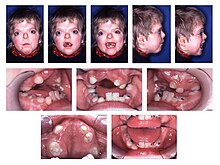Apert syndrome
| Classification according to ICD-10 | |
|---|---|
| Q87.0 | Congenital malformation syndromes with predominant involvement of the face - acrocephalosyndactyly syndrome (Apert) |
| ICD-10 online (WHO version 2019) | |
The Apert syndrome , also called Acrocephalosyndactyly is a genetically controlled specialty based on a mutation of the FGFR2 gene on chromosome 10 results in the physical to a variety of malformations. The syndrome was described in 1906 by the French pediatrician Eugene Apert . It belongs to the group of craniofacial malformations , which also includes Carpenter syndrome , Crouzon syndrome , Pfeiffer syndrome and Saethre-Chotzen syndrome .
frequency
Around 400 people in Germany live with the syndrome. The prevalence is around 1–9: 100,000.
Symptoms and characteristics
possible are:
- Head area:
- Overgrowth of skull bones with the risk of pressure on the brain and the formation of hydrocephalus
- Malformation of the upper jaw
- open cleft palate
- impaired hearing
- Visual impairment
- epilepsy
- impaired breathing
- Neck:
- a high percentage of segmentation disorders of the cervical spine
-
Extremities :
- fingers and toes that have grown together (always occurs symmetrically)
- Stiffened or missing central joints
- Bone structure:
- Restricted movement in many joints
- Curvature of the spine ( scoliosis )
- Psychologically:
- Problems with social and emotional development ("being different")
Diagnosis
In prenatal diagnosis , typical features can already be noticed in the early stages of pregnancy in the context of fine ultrasound. The symptoms are often misinterpreted due to the rare occurrence of the syndrome. A diagnosis can be made prenatally by examining the amniotic fluid if there is an initial suspicion and a targeted test for Apert syndrome is carried out. Most of the physical features are evident in the postpartum period and a molecular genetic analysis can confirm the findings.
treatment
Immediate or as soon as possible treatment by specialists is extremely important for the development of children and the prevention of consequential damage. The main ones to be mentioned here are:
- Sealed cranial sutures will most likely require cranial surgery to prevent a lack of space for the growing brain.
- Separation operations on fingers and toes.
- Examinations for breathing, hearing, cleft palate, ...
It is also advisable to contact the relevant parents' initiative.
Inheritance
The inheritance is autosomal - dominant with complete penetrance and high variance (the expression is very variable depending on the mutation and the individual)
- Fibroblast growth factor receptor (FGFR2) gene
- various mutations activate the receptor and thus primarily strengthen the signal for changes in the differentiation of bone and cartilage tissues
- 80% new mutations, paternal age effect
The hypochondroplasia (lighter manifestation) and the thanatophoric dysplasia (severe and lethal manifestation) show mutations in the same FGFR3 gene.
literature
- Michael Eckardt: About four cases of acrocephalosyndactyly. Dissertation . Feder, Mediasch (Transylvania) 1932, OCLC 238858702
Web links
- Homepage of the parents' initiative Apert Syndrom and related malformations eV
Individual evidence
- ^ Apert E .: De l'acrocephalosyndactyly. In: Bull Soc Méd Hôp Paris . tape 23 , 1906, pp. 1310 .
- ↑ Apert syndrome. In: Orphanet (Rare Disease Database).
- ↑ Apert syndrome. In: Online Mendelian Inheritance in Man . (English)

